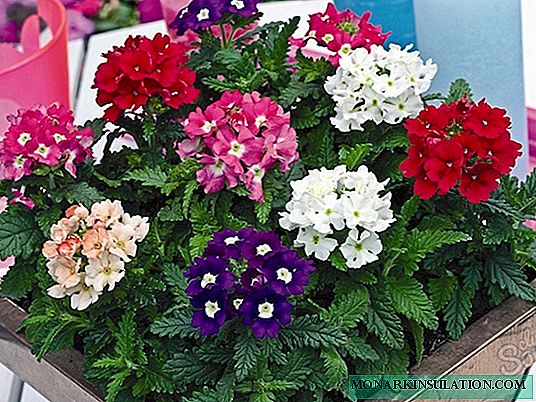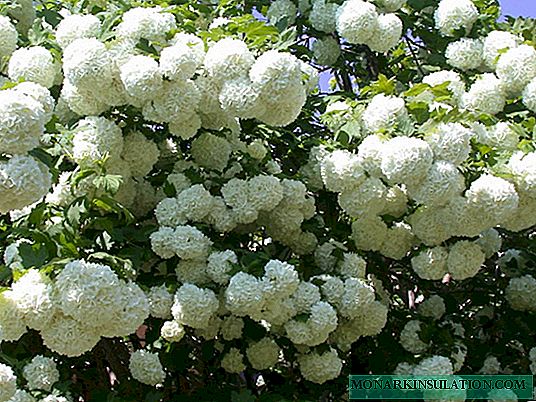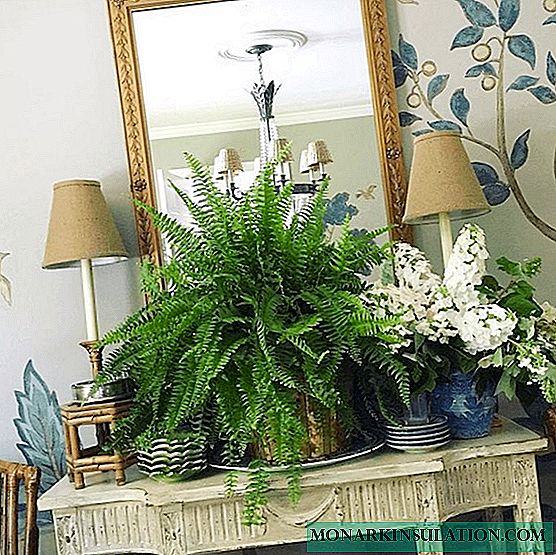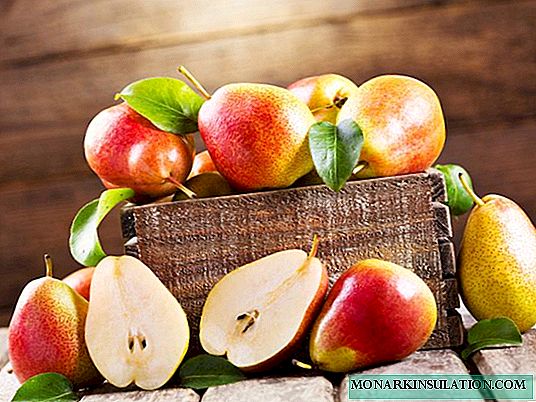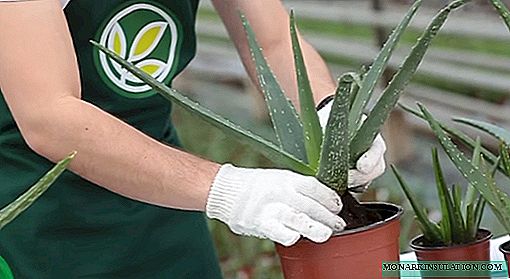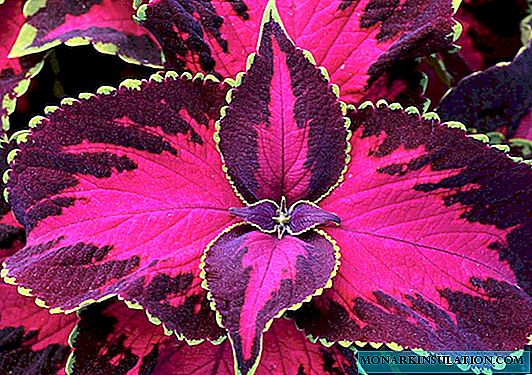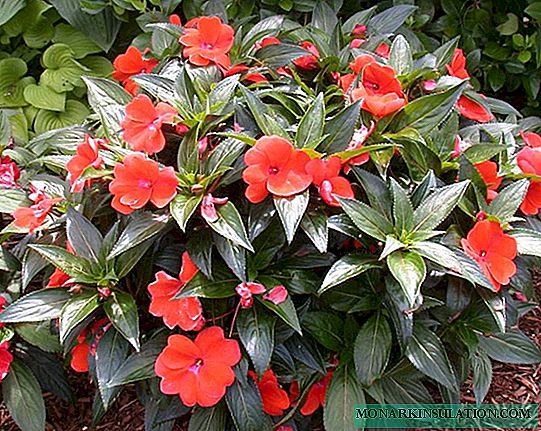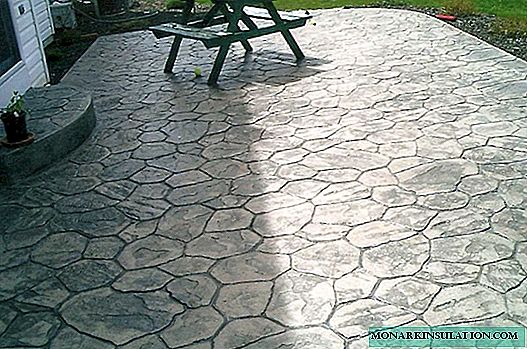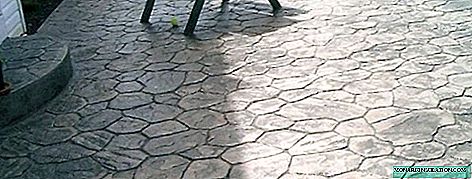
When looking at the beautiful relief coatings of walls, walkways and fences, it is hard to imagine that they are all made of the usual material - concrete. But modern coatings, unlike their "ancestor", known for its unattractive dull gray appearance, have a special aesthetics. Due to its presentable properties, decorative concrete is widely used not only in construction, but also in landscape design.
For the first time, decorative concrete was used by the Americans in the early 60s of the last century in the construction of runways at military airfields. They were faced with the task of creating a building material that successfully combines both excellent performance and decorative qualities. The material, which consisted of cement, water, aggregate, paint and additives, fully complied with these requirements and therefore was widely used in many industries.
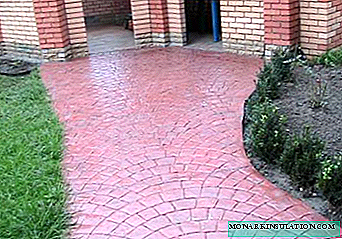
Today, decorative concrete can be seen at car parks, roads and sidewalks, subway stations. It is used in the restoration of architectural monuments.
Thanks to the efforts of developers today, decorative concrete has a number of undeniable advantages, the main ones of which are:
- Resistance to the effects of petroleum products, chemicals and aggressive compounds;
- The ability to withstand the load (2-3 times more than the pressed paving slabs);
- UV stability and the ability to withstand up to 300 freezing cycles;
- The ability to withstand temperature changes in the range from -40 ° C to + 40 ° C;
- Resistant to abrasion and mechanical stress.
Using pressed concrete, extremely beautiful yet durable coatings can be created. Special additives that are part of the material help prevent delamination and cracking of the surface.
Unlike ordinary concrete, the technology of which is reduced to ordinary pouring, decorative concrete involves applying a certain pattern to the top layer after the final pouring.
Various dies and other special tools are used to decorate the surface. Stencils, molds for sandblasting and etching chemicals allow you to create complex ornaments, and thin lines made by saws with diamond blades are able to give expressiveness and clarity to the picture.
How to apply this miracle in site design
Using modern technologies for the manufacture of concrete surfaces, manufacturers produce material that is able to create the effect of not only natural stone, but also wood, brick, decorative tiles and other relief coatings.
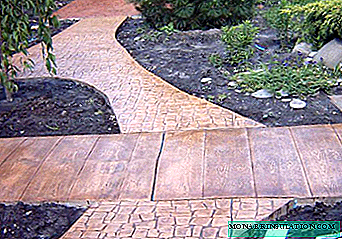
In landscape design, decorative concrete is used in the arrangement of recreational areas, the design of garden paths and the construction of landscape gardening elements
Such concrete is suitable not only for the arrangement of sites and paths. It is used in the creation of fences and the manufacture of small architectural forms.
Decorative concrete fences can have any surface, starting from traditional brick and stone, and ending with an imitation of Parthenon bas-reliefs.

Picturesque balusters, outwardly resembling low columns, and graceful railings are not inferior in beauty to sophisticated marble and alabaster figures
Balusters made of concrete look spectacularly as fences of arbors and verandas, supports for railings. The lonely columns twisted by climbing plants, concrete floor flowerpots and flower girls can make elegant decoration of the garden. A stucco fountain made of concrete will be in the spotlight.
Garden benches cast from concrete are some of the most practical garden structures. Depending on the style of execution, they can easily be included in the landscape design, making an elegant addition to the site.

This decorative concrete garden bench combines beauty and practicality - it’s always nice to sit down and relax on it
Varieties of finishing material
Three main varieties of decorative concrete are distinguished depending on the options for the components of the material and the effect it creates.
Colored concrete
The color range of coloring pigments used in the manufacture of decorative concrete, has more than twenty shades.

Thanks to a wide palette of shades, colored concrete is able to successfully complement the architectural and floral composition of the suburban area, acting as a worthy decoration of the access road, parking space and garden paths
To obtain colored concrete, manufacturers use special coloring pigments, which, thanks to a special hardener, are able to maintain color fastness even in conditions of negative environmental impact. Most often, such pigments are oxides and salts of various metals. For example, to give concrete a greenish tint, chromium oxide is added, reddish - iron oxide, and violet - manganese oxide.
Imitation natural stone
Using innovative diamond processing technologies, manufacturers can produce concrete, which creates the effect of full compliance with surfaces made from natural materials laid out hundreds of years ago.
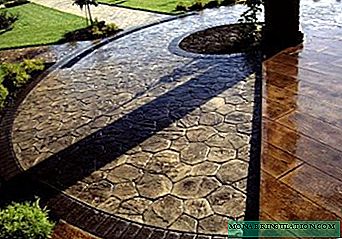
In the master’s skillful hands, concrete is able to take the form of any natural material, whether it be paving stones, brick, slate, cobblestone and even marble
The imitation is so believable that even with a thorough examination it is not always possible to determine whether it is a natural stone or whether it is a skillfully made copy of it.
Embossed Coatings
Decorative concrete with an expressive structure is created by adding coarse aggregate to the composition. The desired effect is achieved by exposing the grains that come to the surface after removal with tools or special solutions of the upper layer.

Such decorative concrete can turn an ordinary sidewalk into an old pavement, and the patio into an extravagant Spanish patio
When creating concrete with a relief structure, aggregates of crushed marble, granite, anthracite, limestone and basalt are used. Spectacular surfaces are obtained using aggregates of gray, red and pink shades.
Self-made decorative concrete
Decorative concrete is ideal for arranging walkways and decorating a garden. With excellent quality characteristics, it is particularly aesthetically pleasing. In addition, the concrete coating is convenient for cleaning, and it is resistant to grease and oil. Platforms and alleys with such a coating do not need to install a border, so you can save a little on construction.
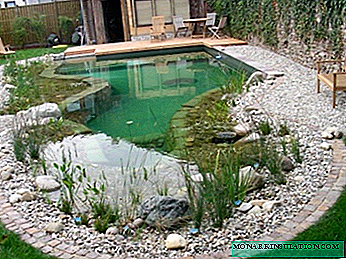
Platforms and alleys with such a coating do not need to install a border, so you can save a little on construction
If desired, decorative concrete can be made with your own hands. Dry mix and the form for its preparation can be purchased at any hardware store.
The design option depends on your preference. On sale you can find plastic or silicone forms, including combinations of rhombuses and squares, drawings "fan", "exec", "animal skin", "basket weaving".
The technology for creating a relief surface includes several stages:
- Foundation preparation. When making a garden path in the marked area, a soil layer of 10 cm deep is removed, the formwork is laid and a layer of rubble is poured.
- Pouring concrete. On a leveled surface spread cement mortar and smooth.
- Application of color hardener. To give the surface the desired shade, the solution is sprinkled with dry bulk dyes or treated with a colored hardener, which in addition to coloring pigments includes a granite or quartz sand filler.
- Mold pressing. On the grasped, but not completely frozen surface, lay out the forms, closely pressing them to each other. To get a clear print of the pattern, the stacked forms are slightly tamped. You can determine the readiness for stamping concrete mix by touching it with your finger. The mixture is ready if it does not reach for it.
- Coating cleaning. After standing for 2-3 days, they wash the surface of the concrete with a brush moistened in a solution with hydrochloric acid. After the top layer has completely dried, a protective composition is applied that prevents the evaporation of moisture from the surface of fresh concrete.
In places of a likely break, expansion joints should be provided by performing them at a distance of 6 meters from each other and filling the voids with a colorless sealant.
In order to extend the service life of concrete and significantly improve the aesthetic properties of the material, it is desirable to treat the surface with a special impregnating compound forming a protective film.
The decorative concrete track can be used in 10-15 days. Ideally, it is desirable to treat the concrete surface with hydrophobizing solutions every year.

